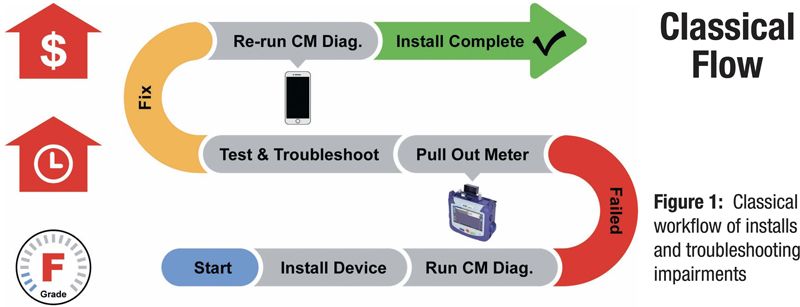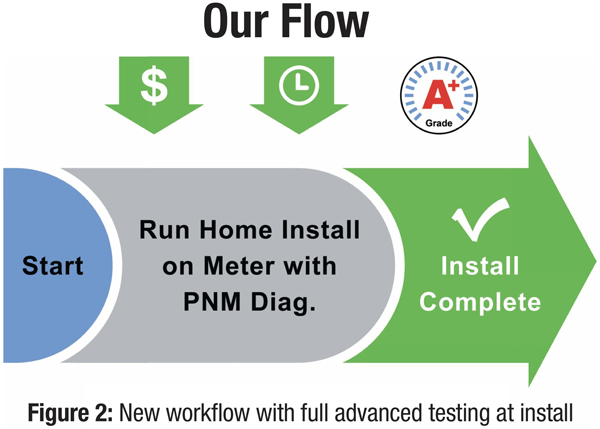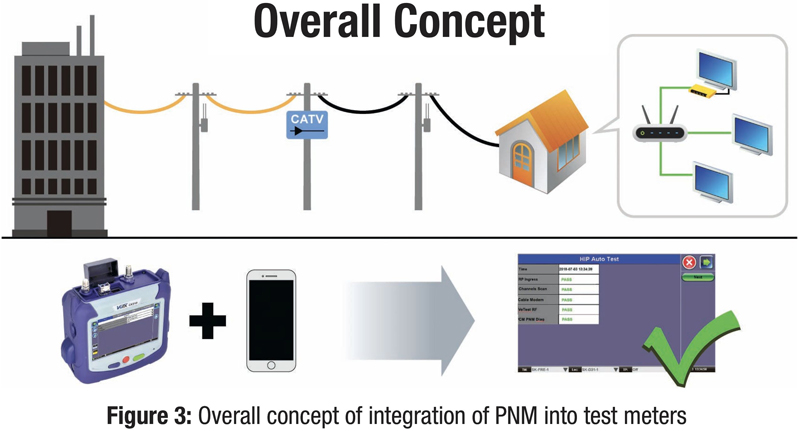PNM: Taking Broadband by Storm
By Cyrille Morelle and Brady Volpe
The subscriber’s increasing expectations of quality of experience (QoE) and network speed has pushed the development of more demanding protocols. The industry is now rolling out DOCSIS 3.1 OFDMA to the field and many providers are planning their transitions to the upcoming full duplex bidirectional communication (FDX) standard. However, with these standards comes more advanced cable modems capable of acting as permanent monitoring equipment, all the way to the end-of-line. These cable modems’ measurement capabilities exceed modern day test equipment.
Along with performance expectations, the subscriber has become intolerant of network interruptions. With IoT (Internet of Things) devices around our home playing a bigger part in our daily lives and more employees working from home, any interruption in service triggers customer service representative (CSR) calls. Subscribers expect a quick response to their issues and are not willing to wait a couple of days for a field technician. Today’s subscribers have options with other service providers, so they are willing to jump ship.
Additionally, network expansion has added another layer of complexity, as technicians strive to solve issues as quickly as possible. Home certification programs and other organizational changes, as well as new tool sets, have been adopted by many providers to help technicians in the field become more effective.
The demanding network environment along with the increased diagnostic capability of the DOCSIS end-of-line equipment has given birth to proactive network maintenance (PNM). PNM detects issues quickly and results in lowered maintenance costs by reducing blind truck rolls and CSR calls for the operator.
PNM lowers maintenance costs by identifying the presence of upstream RF impairments and identifying the location of the impairments using cable modem termination systems (CMTSs). and cable modems. Narrowing down the location where the impairment occurs reduces the time and cost to resolve the impairment proactively before it impacts subscribers.
The value of PNM can be further increased by leveraging PNM’s inherit capability for trend analysis and identifying correlation groups. PNM can improve the quality of service (QoS) for subscribers by identifying various impairments in the plant before traditional alarms go off indicating there is an issue in the network and ideally before the issue impacts subscribers, hence improving QoE.
Implementing this new approach enables service providers to avoid unnecessary CSR calls by proactively monitoring their network. Traditional alarms have been exchanged for real-time and robust data to pinpoint impairments, so the operator can resolve them FAST. This all translates to an increase in the quality of the customer experience. However, despite its advantages, PNM, when integrated into test meters, can be greatly enhanced.

PNM alone provides only part of the picture
PNM uses every cable modem as an end-of-line monitoring probe. During new installs PNM queries the new cable modem from the PNM server to ensure it is installed correctly. In cases where the modem is unable to come online, such as bad downstream levels or upstream impairments, PNM cannot communicate with the modem and complete the PNM certified installation. In instances like these a basic field meter can help in diagnosing connectivity issues without having to connect back to the CMTS — this is where PNM and field meter integration shine.
PNM is very effective in detecting in-home wiring or drop-related issues inside the subscriber’s home. However, once you are inside the home it may be difficult to identify location of impairments because the cable modem is not active on all the home’s RF network. Normally, the cable modem is stationary in the home and it’s not conducive to move it around the home to test individual outlets. A field test meter with a built-in cable modem teamed with PNM technology can be used to locate impairments in and near the home by relocating it and reviewing the PNM tests. The test meter/cable modem can be moved to the tap, ground block, amplifier, or throughout the subscriber’s home.
A test meter with advanced PNM technology would add even more value to providers. Technicians can trigger diagnostics from the test meter itself, instead of juggling between the meter and a smartphone or other device with a PNM toolset. Since the test meter acts as a modem, there is no need to search for the cable modem’s MAC address on a PNM app. The test meter knows its MAC address and will filter results for its own MAC address by default. An option to override this default may also be selected, so that other MAC addresses can be searched (for example, the subscriber’s own cable modem). Integrated results and integrated dashboards that cross both reactive and proactive systems will create a single location and single set of metrics. It will no longer be required to query multiple systems to generate an overall view of the system health.

VeEX CX310 with Nimble This PNM: the best of both worlds
The growing trend for proactive network maintenance teams is still needed, especially as OFDMA and FDX come online. However, instead of having two devices, a DOCSIS 3.1 test meter and a PNM tool, you can use a test meter with PNM inside to provide the best test solution. VeEX’s CX310, integrated with the Nimble This PNM tool, provides the classic metrics needed to identify problems, along with PNM metrics to provide a full system check for today’s advanced cable modems.
Use the CX310 test meter to perform a full home installation process (HIP) auto test for home certification conformance testing. It will produce a single report that contains both a PNM birth certificate and a HIP test report, providing a single result so the technician does not have to manage multiple devices to get a complete view. Use the PNM metrics on the meter to test the modem at install according to specified parameters. This ensures a quality install the first time, saving time, RR (repeats), and increasing efficiency and customer satisfaction.
When the PNM’s birth certificate does fail you can depend with full confidence on the CX310 test meter to give a field technician the ability to troubleshoot the network without a working cable modem.

The value of CX310 with PNM technology
As cable operators continue with the deployment of DOCSIS 3.1, test meters integrated with PNM technology become even more critical. It limits the number of touches a technician has once in the field.
Using the CX310 test meter at a subscriber’s house performing all the tasks of the meter and PNM advanced testing, including full band capture, means checking only one screen and not multiple screens on multiple devices which is faster, more accurate and more efficient for the technician. DOCSIS 3.1 is taking cable plants to the next level. With the combined strength of the VeEX CX310 test meter integrated with Nimble This PNM, your customers will get the QoE they deserve.
About VeEX CX310 Handheld DOCSIS 3.1 Installation Test Set
Equipped with a true DOCSIS 3.1 cable modem supporting OFDM analysis and insightful subcarrier scans that pinpoint plant issues, VeEX’s CX310 installation meter offers unrivalled price and performance in a lightweight, ultra-portable form factor. VeTest speed test measurements, for both the RF and Ethernet test interfaces, provide undeniable proof of service delivery to end subscribers. Additional features include VeCheck Full Band Scan, HIP Home Certification, TDR fault location and PNM diagnostics.

Cyrille Morelle
President and CEO, VeEX Inc.
cmorelle@veexinc.com
Cyrille Morelle is president and CEO for VeEX Inc. In this role he is responsible for global operations, product development and technology strategy. Cyrille co-founded VeEX in 2006 and serves as a member of the board of directors.
 Brady Volpe
Brady Volpe
President and founder, Nimble This LLC. and The Volpe Firm, Inc.
brady.volpe@nimble-this.com
Brady Volpe is founder of The Volpe Firm, Inc. and Nimble This LLC. He has 25 years of broadband cable and telecommunications experience, specializing in DOCSIS, PNM, RF, system design, troubleshooting and Internet protocol.





